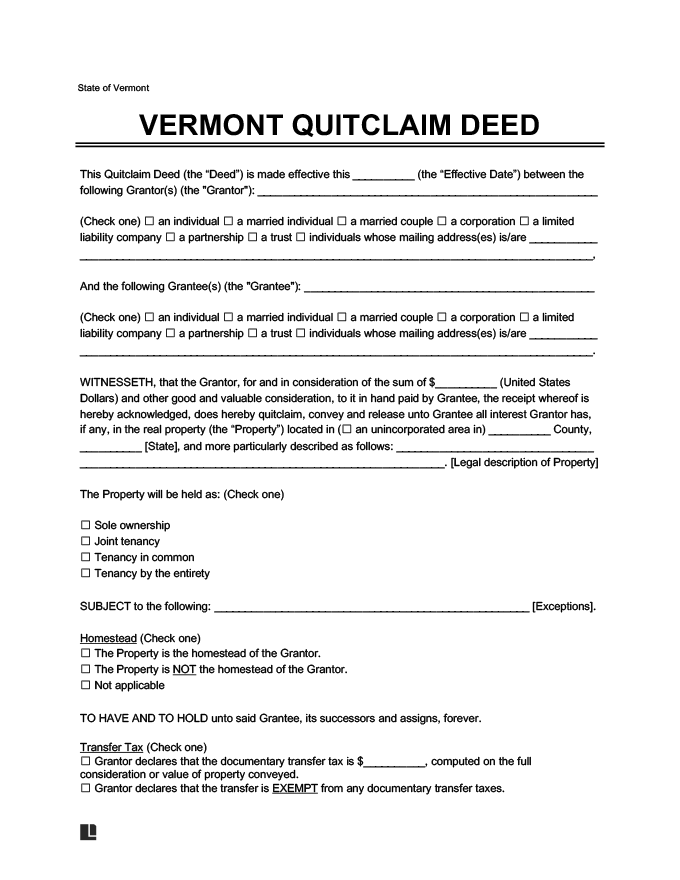In Vermont, a quitclaim deed serves as a legal instrument for conveying property ownership. It finds frequent use in scenarios involving property gifting, rectifying title errors, or adjusting ownership following life events such as inheritance, marriage, or divorce.
Through this document, the grantor (seller) relinquishes their stake in the property to the grantee (buyer) without guaranteeing ownership or addressing potential title concerns. Essentially, the grantor forfeits their claim to the property while absolving themselves of responsibility for any title issues that may emerge post-transfer.
Legal Framework
Vt. Stat. Tit. 27, Ch. 5 dictates the legal requirements behind property ownership and transfers in the state.
Legal Description
While Vermont doesn’t specify the exact language or details needed for a legal description of the property being transferred, it generally includes the address, a land survey, and references to lot numbers and monuments. Check the previous deed and copy its legal description exactly to ensure a smooth process when filing your quitclaim deed.
Signing
Per Vt. Stat. Tit. 27 § 301, the state requires a notary public to acknowledge the grantor’s signature on a quitclaim deed.
Terminology
Unlike more stringent states, Vermont doesn’t have many requirements for the specific language a quitclaim deed must have to be valid. An enforceable deed will likely have language that “remises, releases, and quitclaims” the property to the grantee. The deed should also clarify that the grantor is not making any warranties.
Additional Documents
A transfer tax document, Form PTT-172, must accompany your quitclaim deed for the town clerk’s office to accept it. Please ensure to fill out all fields and note if the conditionally required fields apply to your situation.
Filing
Per Vt. Stat. Tit. 27 § 341, the grantor must submit a signed and notarized quitclaim deed to the town clerk’s office where the property rests. Unlike other states, Vermont has no county recording system, so the relevant town or city records all documents.
Validity and Content Requirements
Vt. Stat. Tit. 27 § 341 cites some requirements for a property deed to be valid. Here are the requirements for your quitclaim deed to be enforceable:
- The grantor’s name and address.
- The grantee’s name and address.
- The consideration amount.
- The property’s address and legal description.
- Details of the property’s ownership (especially if multiple parties will own the property).
- The grantor’s signature.
- A notary’s acknowledgment of the grantor’s signature.
Quitclaim Deeds vs. Other Property Transfer Methods
| Quitclaim Deed | Only passes the title that the grantor has at the time of the transfer but doesn't make any guarantees about its quality. |
| Warranty Deed | Guarantees that the grantor has possession of the property and title to the property. Also promises that the property doesn't have undisclosed encumbrances and that the grantor will defend against third-party claims. |
| Limited (Special) Warranty Deed | Similar to a warranty deed but states that the grantor will take no responsibility for the title's state before they acquired it. |
| Easement Deed | Provides the right to use a property for a specific purpose. |
| Deed to a Trust | Lets the current trustee convey property that's currently in a trust. |
| Life Estate Deed | Divides the claim to ownership into two parts: (1) the "life estate," which the current property owner retains and (2) the "remainder interest" that the beneficiary receives after the owner's passing. |
| Lady Bird Deed (Enhanced Life Estate Deed) | Similar to a life estate deed but the owner maintains full control. The beneficiary doesn't receive control until the owner passes away. |
